Organisational Behaviour Report: Team Performance and Solutions
VerifiedAdded on 2022/09/16
|10
|2289
|18
Report
AI Summary
This report, prepared by a group of graduate trainees, analyzes organisational behaviour within a medium-sized private organisation. It identifies key issues impacting team performance, including lack of teamwork, transparency, and communication, and negative corporate culture. The report examines these issues through the lens of organisational behaviour theories and proposes recommendations to address them. These recommendations include fostering trust, improving communication skills, enhancing transparency, and implementing motivational strategies to create a more positive and productive work environment. The report emphasizes the importance of leadership in building a highly functional team and suggests practical steps to improve team dynamics and achieve successful graduate training programs.
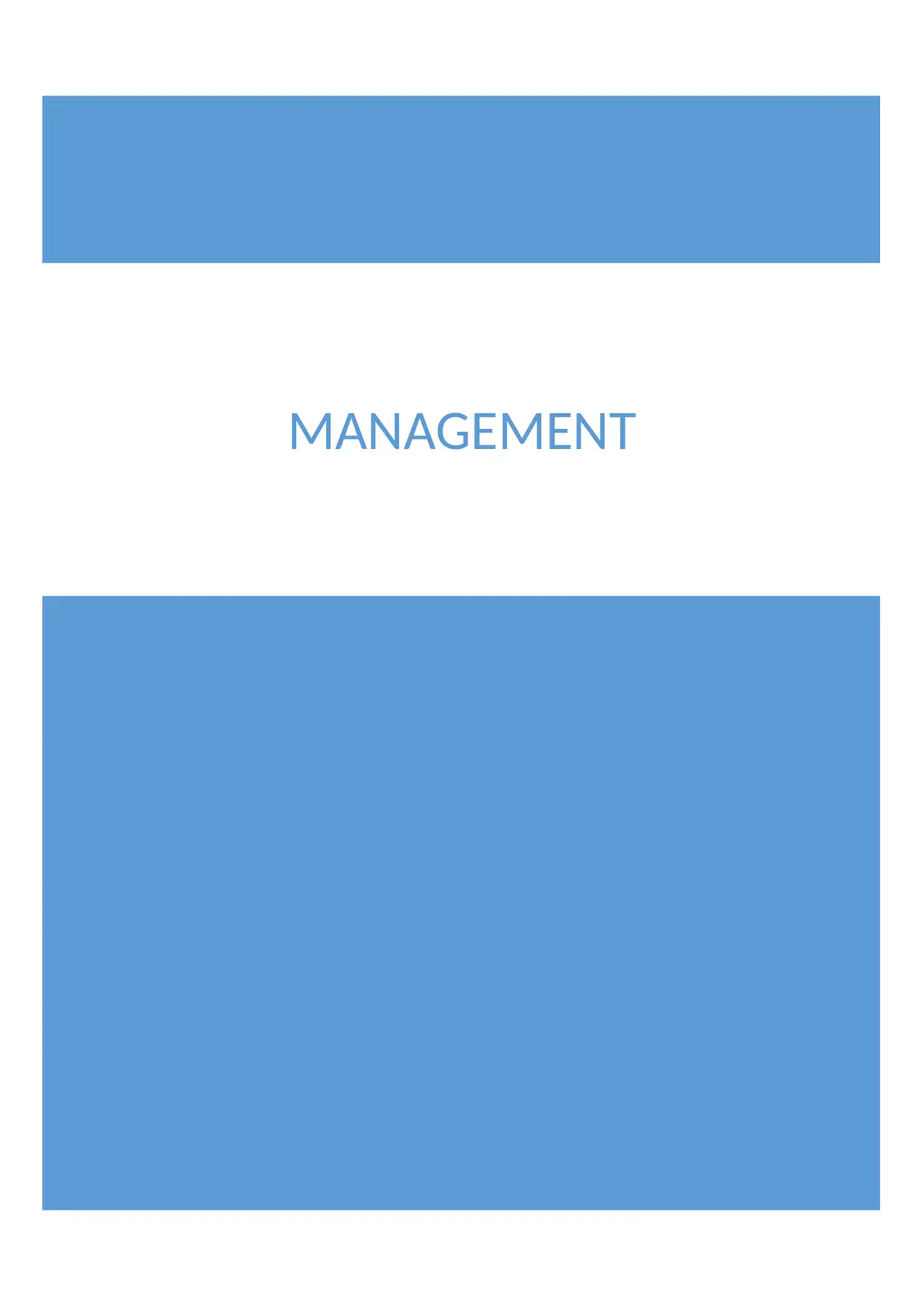
MANAGEMENT
Paraphrase This Document
Need a fresh take? Get an instant paraphrase of this document with our AI Paraphraser

Contents
Introduction................................................................................................................................3
Examination of team composition.............................................................................................3
Identification of three issues affecting team performance.........................................................4
Recommendations to each organisational behaviour issue........................................................6
Conclusion..................................................................................................................................8
References..................................................................................................................................9
Introduction................................................................................................................................3
Examination of team composition.............................................................................................3
Identification of three issues affecting team performance.........................................................4
Recommendations to each organisational behaviour issue........................................................6
Conclusion..................................................................................................................................8
References..................................................................................................................................9
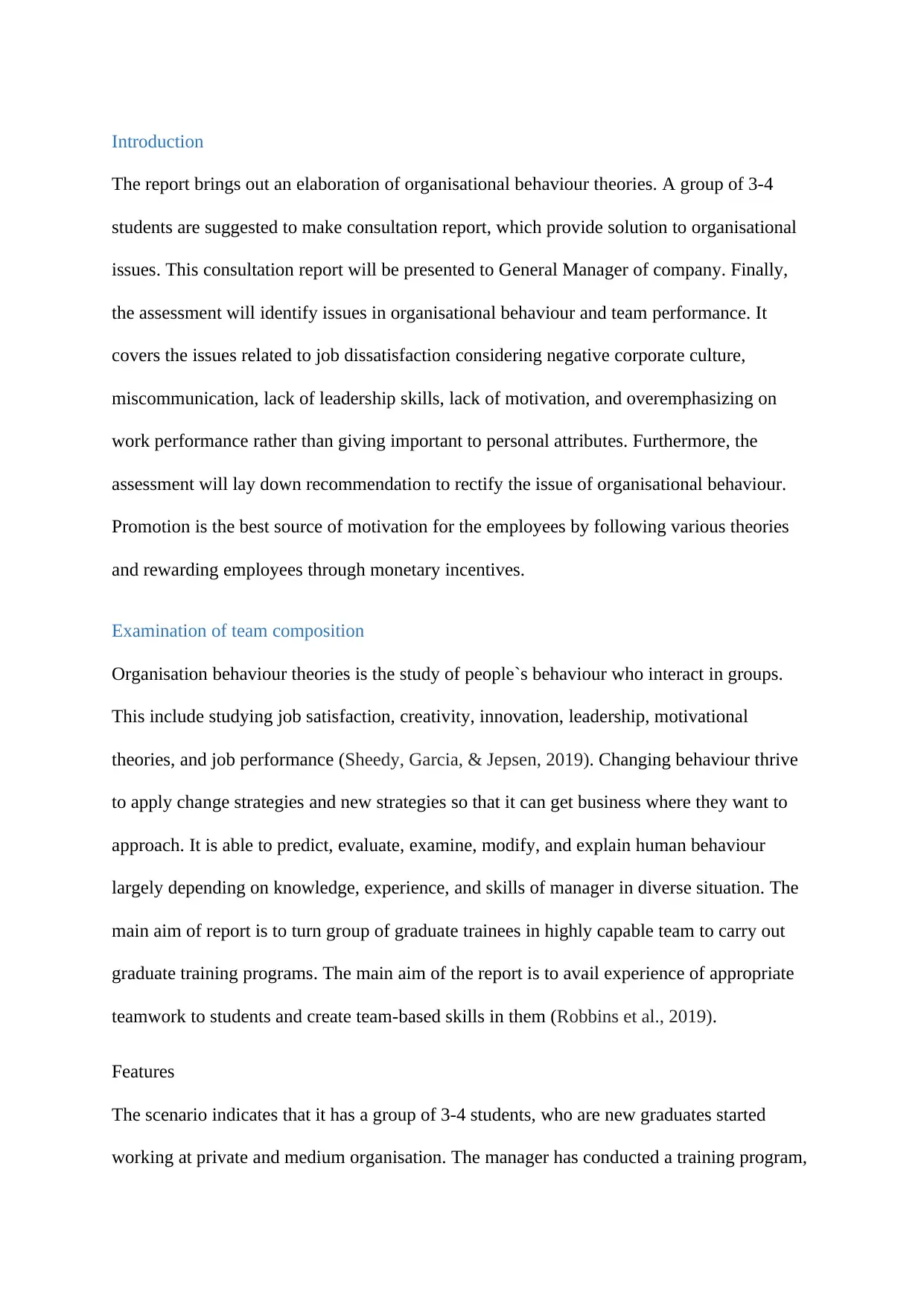
Introduction
The report brings out an elaboration of organisational behaviour theories. A group of 3-4
students are suggested to make consultation report, which provide solution to organisational
issues. This consultation report will be presented to General Manager of company. Finally,
the assessment will identify issues in organisational behaviour and team performance. It
covers the issues related to job dissatisfaction considering negative corporate culture,
miscommunication, lack of leadership skills, lack of motivation, and overemphasizing on
work performance rather than giving important to personal attributes. Furthermore, the
assessment will lay down recommendation to rectify the issue of organisational behaviour.
Promotion is the best source of motivation for the employees by following various theories
and rewarding employees through monetary incentives.
Examination of team composition
Organisation behaviour theories is the study of people`s behaviour who interact in groups.
This include studying job satisfaction, creativity, innovation, leadership, motivational
theories, and job performance (Sheedy, Garcia, & Jepsen, 2019). Changing behaviour thrive
to apply change strategies and new strategies so that it can get business where they want to
approach. It is able to predict, evaluate, examine, modify, and explain human behaviour
largely depending on knowledge, experience, and skills of manager in diverse situation. The
main aim of report is to turn group of graduate trainees in highly capable team to carry out
graduate training programs. The main aim of the report is to avail experience of appropriate
teamwork to students and create team-based skills in them (Robbins et al., 2019).
Features
The scenario indicates that it has a group of 3-4 students, who are new graduates started
working at private and medium organisation. The manager has conducted a training program,
The report brings out an elaboration of organisational behaviour theories. A group of 3-4
students are suggested to make consultation report, which provide solution to organisational
issues. This consultation report will be presented to General Manager of company. Finally,
the assessment will identify issues in organisational behaviour and team performance. It
covers the issues related to job dissatisfaction considering negative corporate culture,
miscommunication, lack of leadership skills, lack of motivation, and overemphasizing on
work performance rather than giving important to personal attributes. Furthermore, the
assessment will lay down recommendation to rectify the issue of organisational behaviour.
Promotion is the best source of motivation for the employees by following various theories
and rewarding employees through monetary incentives.
Examination of team composition
Organisation behaviour theories is the study of people`s behaviour who interact in groups.
This include studying job satisfaction, creativity, innovation, leadership, motivational
theories, and job performance (Sheedy, Garcia, & Jepsen, 2019). Changing behaviour thrive
to apply change strategies and new strategies so that it can get business where they want to
approach. It is able to predict, evaluate, examine, modify, and explain human behaviour
largely depending on knowledge, experience, and skills of manager in diverse situation. The
main aim of report is to turn group of graduate trainees in highly capable team to carry out
graduate training programs. The main aim of the report is to avail experience of appropriate
teamwork to students and create team-based skills in them (Robbins et al., 2019).
Features
The scenario indicates that it has a group of 3-4 students, who are new graduates started
working at private and medium organisation. The manager has conducted a training program,
⊘ This is a preview!⊘
Do you want full access?
Subscribe today to unlock all pages.

Trusted by 1+ million students worldwide
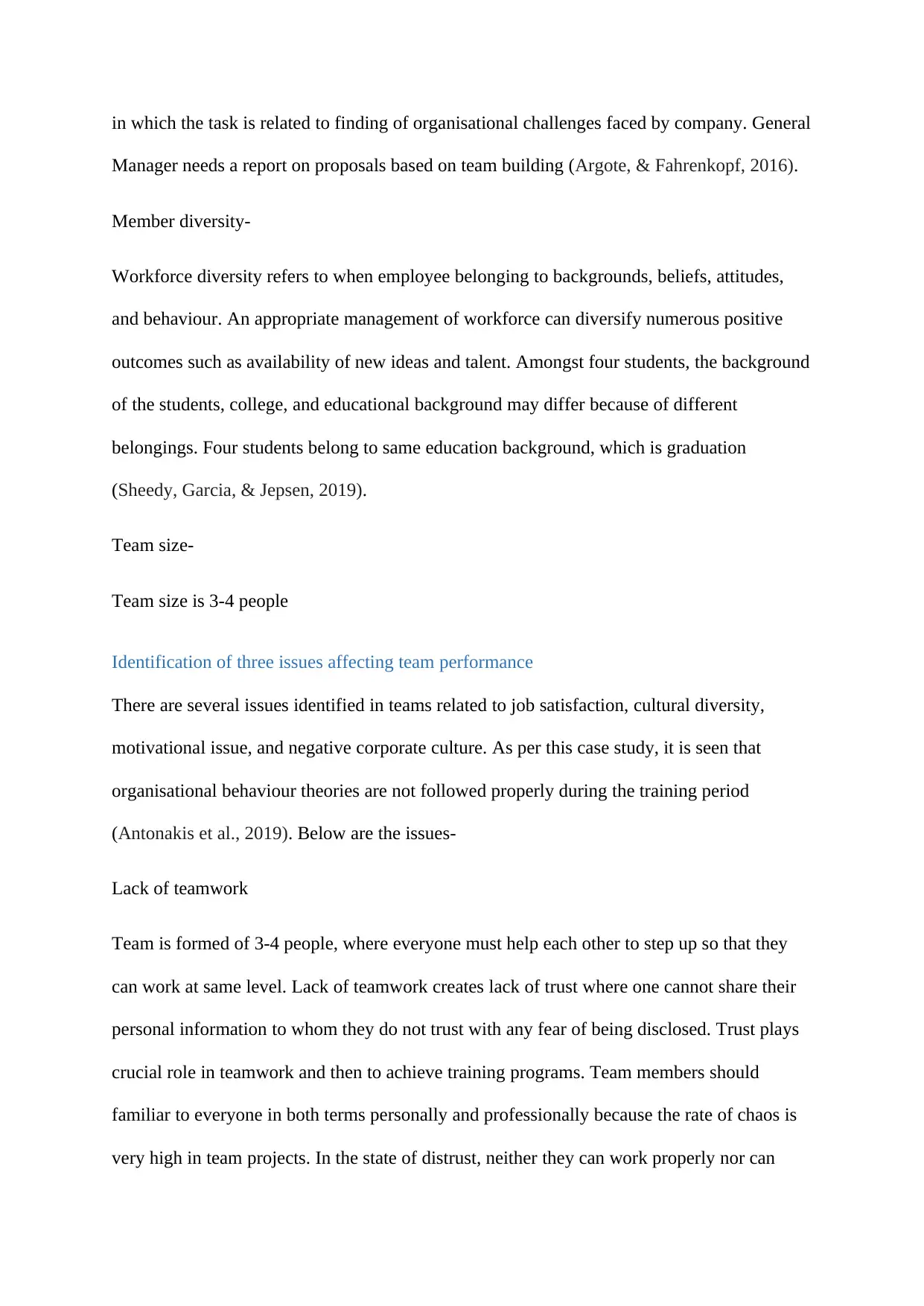
in which the task is related to finding of organisational challenges faced by company. General
Manager needs a report on proposals based on team building (Argote, & Fahrenkopf, 2016).
Member diversity-
Workforce diversity refers to when employee belonging to backgrounds, beliefs, attitudes,
and behaviour. An appropriate management of workforce can diversify numerous positive
outcomes such as availability of new ideas and talent. Amongst four students, the background
of the students, college, and educational background may differ because of different
belongings. Four students belong to same education background, which is graduation
(Sheedy, Garcia, & Jepsen, 2019).
Team size-
Team size is 3-4 people
Identification of three issues affecting team performance
There are several issues identified in teams related to job satisfaction, cultural diversity,
motivational issue, and negative corporate culture. As per this case study, it is seen that
organisational behaviour theories are not followed properly during the training period
(Antonakis et al., 2019). Below are the issues-
Lack of teamwork
Team is formed of 3-4 people, where everyone must help each other to step up so that they
can work at same level. Lack of teamwork creates lack of trust where one cannot share their
personal information to whom they do not trust with any fear of being disclosed. Trust plays
crucial role in teamwork and then to achieve training programs. Team members should
familiar to everyone in both terms personally and professionally because the rate of chaos is
very high in team projects. In the state of distrust, neither they can work properly nor can
Manager needs a report on proposals based on team building (Argote, & Fahrenkopf, 2016).
Member diversity-
Workforce diversity refers to when employee belonging to backgrounds, beliefs, attitudes,
and behaviour. An appropriate management of workforce can diversify numerous positive
outcomes such as availability of new ideas and talent. Amongst four students, the background
of the students, college, and educational background may differ because of different
belongings. Four students belong to same education background, which is graduation
(Sheedy, Garcia, & Jepsen, 2019).
Team size-
Team size is 3-4 people
Identification of three issues affecting team performance
There are several issues identified in teams related to job satisfaction, cultural diversity,
motivational issue, and negative corporate culture. As per this case study, it is seen that
organisational behaviour theories are not followed properly during the training period
(Antonakis et al., 2019). Below are the issues-
Lack of teamwork
Team is formed of 3-4 people, where everyone must help each other to step up so that they
can work at same level. Lack of teamwork creates lack of trust where one cannot share their
personal information to whom they do not trust with any fear of being disclosed. Trust plays
crucial role in teamwork and then to achieve training programs. Team members should
familiar to everyone in both terms personally and professionally because the rate of chaos is
very high in team projects. In the state of distrust, neither they can work properly nor can
Paraphrase This Document
Need a fresh take? Get an instant paraphrase of this document with our AI Paraphraser
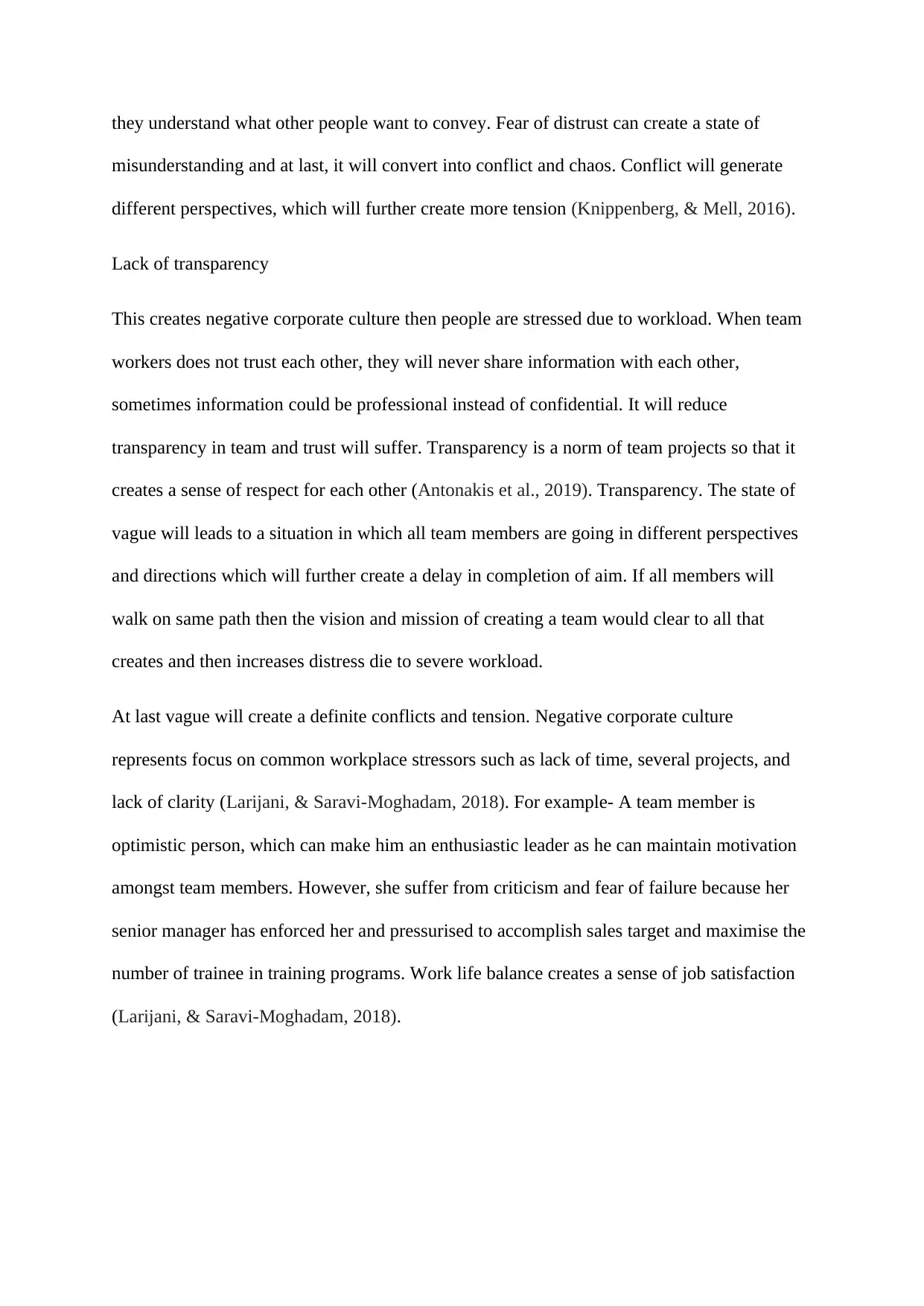
they understand what other people want to convey. Fear of distrust can create a state of
misunderstanding and at last, it will convert into conflict and chaos. Conflict will generate
different perspectives, which will further create more tension (Knippenberg, & Mell, 2016).
Lack of transparency
This creates negative corporate culture then people are stressed due to workload. When team
workers does not trust each other, they will never share information with each other,
sometimes information could be professional instead of confidential. It will reduce
transparency in team and trust will suffer. Transparency is a norm of team projects so that it
creates a sense of respect for each other (Antonakis et al., 2019). Transparency. The state of
vague will leads to a situation in which all team members are going in different perspectives
and directions which will further create a delay in completion of aim. If all members will
walk on same path then the vision and mission of creating a team would clear to all that
creates and then increases distress die to severe workload.
At last vague will create a definite conflicts and tension. Negative corporate culture
represents focus on common workplace stressors such as lack of time, several projects, and
lack of clarity (Larijani, & Saravi-Moghadam, 2018). For example- A team member is
optimistic person, which can make him an enthusiastic leader as he can maintain motivation
amongst team members. However, she suffer from criticism and fear of failure because her
senior manager has enforced her and pressurised to accomplish sales target and maximise the
number of trainee in training programs. Work life balance creates a sense of job satisfaction
(Larijani, & Saravi-Moghadam, 2018).
misunderstanding and at last, it will convert into conflict and chaos. Conflict will generate
different perspectives, which will further create more tension (Knippenberg, & Mell, 2016).
Lack of transparency
This creates negative corporate culture then people are stressed due to workload. When team
workers does not trust each other, they will never share information with each other,
sometimes information could be professional instead of confidential. It will reduce
transparency in team and trust will suffer. Transparency is a norm of team projects so that it
creates a sense of respect for each other (Antonakis et al., 2019). Transparency. The state of
vague will leads to a situation in which all team members are going in different perspectives
and directions which will further create a delay in completion of aim. If all members will
walk on same path then the vision and mission of creating a team would clear to all that
creates and then increases distress die to severe workload.
At last vague will create a definite conflicts and tension. Negative corporate culture
represents focus on common workplace stressors such as lack of time, several projects, and
lack of clarity (Larijani, & Saravi-Moghadam, 2018). For example- A team member is
optimistic person, which can make him an enthusiastic leader as he can maintain motivation
amongst team members. However, she suffer from criticism and fear of failure because her
senior manager has enforced her and pressurised to accomplish sales target and maximise the
number of trainee in training programs. Work life balance creates a sense of job satisfaction
(Larijani, & Saravi-Moghadam, 2018).
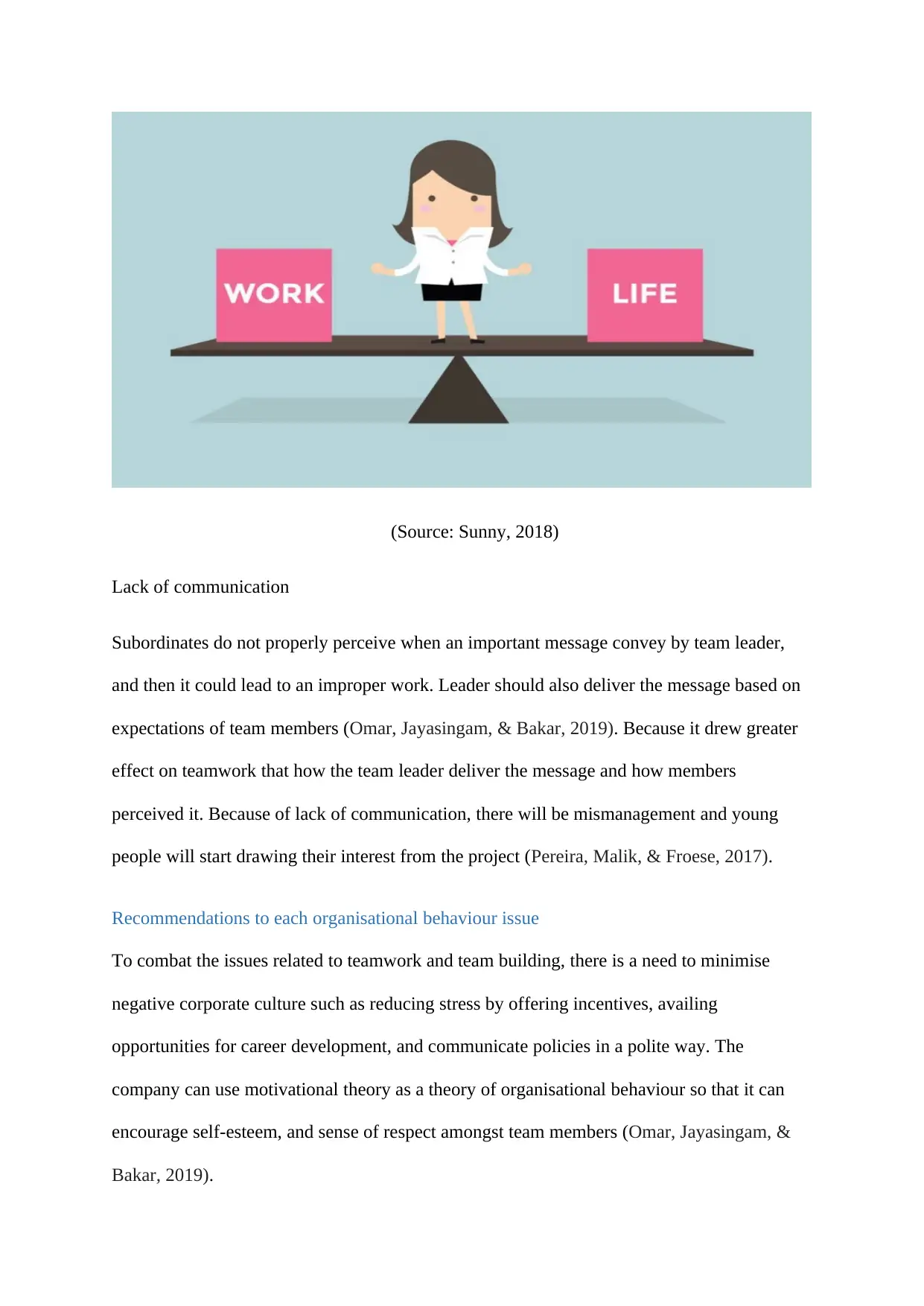
(Source: Sunny, 2018)
Lack of communication
Subordinates do not properly perceive when an important message convey by team leader,
and then it could lead to an improper work. Leader should also deliver the message based on
expectations of team members (Omar, Jayasingam, & Bakar, 2019). Because it drew greater
effect on teamwork that how the team leader deliver the message and how members
perceived it. Because of lack of communication, there will be mismanagement and young
people will start drawing their interest from the project (Pereira, Malik, & Froese, 2017).
Recommendations to each organisational behaviour issue
To combat the issues related to teamwork and team building, there is a need to minimise
negative corporate culture such as reducing stress by offering incentives, availing
opportunities for career development, and communicate policies in a polite way. The
company can use motivational theory as a theory of organisational behaviour so that it can
encourage self-esteem, and sense of respect amongst team members (Omar, Jayasingam, &
Bakar, 2019).
Lack of communication
Subordinates do not properly perceive when an important message convey by team leader,
and then it could lead to an improper work. Leader should also deliver the message based on
expectations of team members (Omar, Jayasingam, & Bakar, 2019). Because it drew greater
effect on teamwork that how the team leader deliver the message and how members
perceived it. Because of lack of communication, there will be mismanagement and young
people will start drawing their interest from the project (Pereira, Malik, & Froese, 2017).
Recommendations to each organisational behaviour issue
To combat the issues related to teamwork and team building, there is a need to minimise
negative corporate culture such as reducing stress by offering incentives, availing
opportunities for career development, and communicate policies in a polite way. The
company can use motivational theory as a theory of organisational behaviour so that it can
encourage self-esteem, and sense of respect amongst team members (Omar, Jayasingam, &
Bakar, 2019).
⊘ This is a preview!⊘
Do you want full access?
Subscribe today to unlock all pages.

Trusted by 1+ million students worldwide
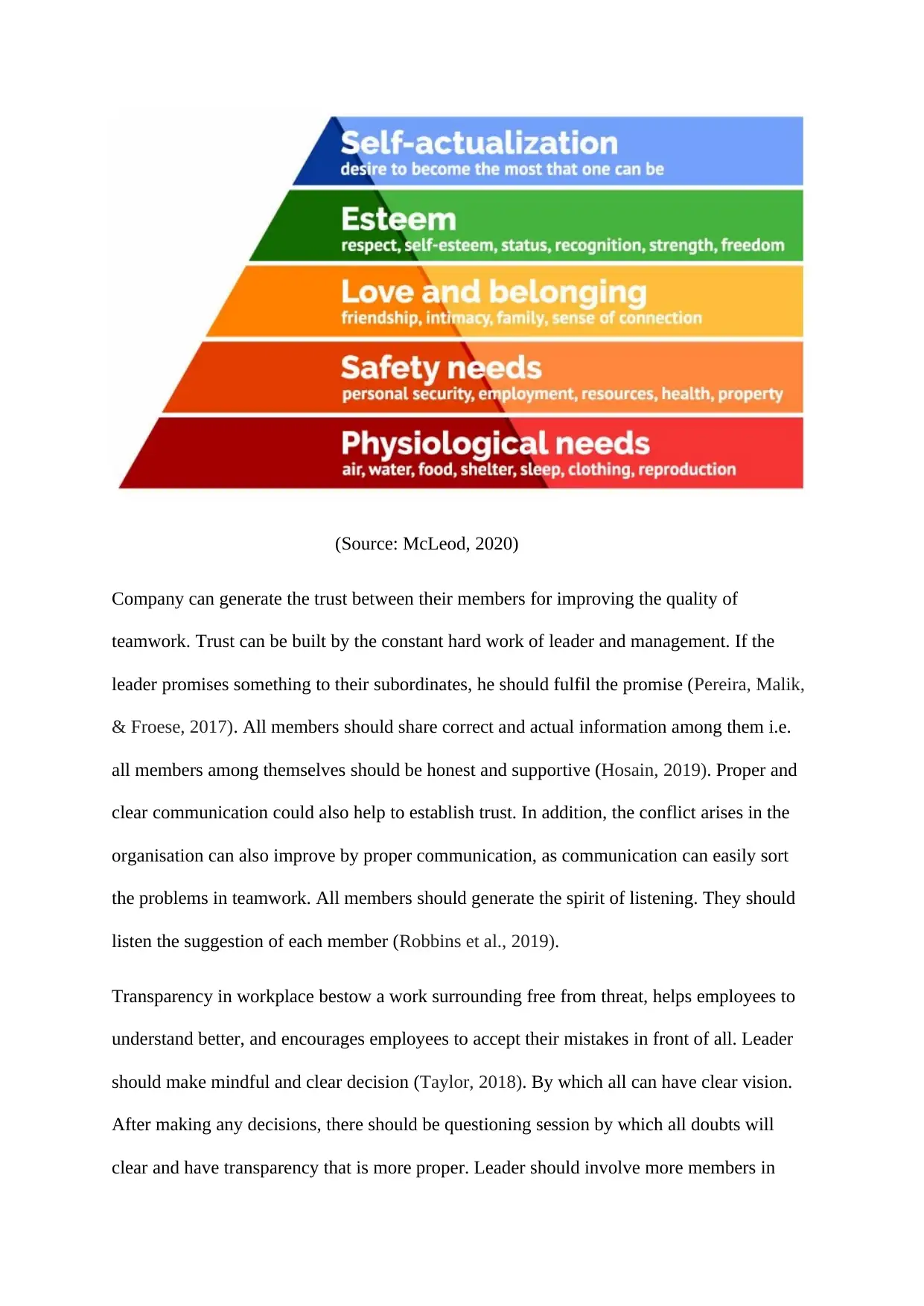
(Source: McLeod, 2020)
Company can generate the trust between their members for improving the quality of
teamwork. Trust can be built by the constant hard work of leader and management. If the
leader promises something to their subordinates, he should fulfil the promise (Pereira, Malik,
& Froese, 2017). All members should share correct and actual information among them i.e.
all members among themselves should be honest and supportive (Hosain, 2019). Proper and
clear communication could also help to establish trust. In addition, the conflict arises in the
organisation can also improve by proper communication, as communication can easily sort
the problems in teamwork. All members should generate the spirit of listening. They should
listen the suggestion of each member (Robbins et al., 2019).
Transparency in workplace bestow a work surrounding free from threat, helps employees to
understand better, and encourages employees to accept their mistakes in front of all. Leader
should make mindful and clear decision (Taylor, 2018). By which all can have clear vision.
After making any decisions, there should be questioning session by which all doubts will
clear and have transparency that is more proper. Leader should involve more members in
Company can generate the trust between their members for improving the quality of
teamwork. Trust can be built by the constant hard work of leader and management. If the
leader promises something to their subordinates, he should fulfil the promise (Pereira, Malik,
& Froese, 2017). All members should share correct and actual information among them i.e.
all members among themselves should be honest and supportive (Hosain, 2019). Proper and
clear communication could also help to establish trust. In addition, the conflict arises in the
organisation can also improve by proper communication, as communication can easily sort
the problems in teamwork. All members should generate the spirit of listening. They should
listen the suggestion of each member (Robbins et al., 2019).
Transparency in workplace bestow a work surrounding free from threat, helps employees to
understand better, and encourages employees to accept their mistakes in front of all. Leader
should make mindful and clear decision (Taylor, 2018). By which all can have clear vision.
After making any decisions, there should be questioning session by which all doubts will
clear and have transparency that is more proper. Leader should involve more members in
Paraphrase This Document
Need a fresh take? Get an instant paraphrase of this document with our AI Paraphraser
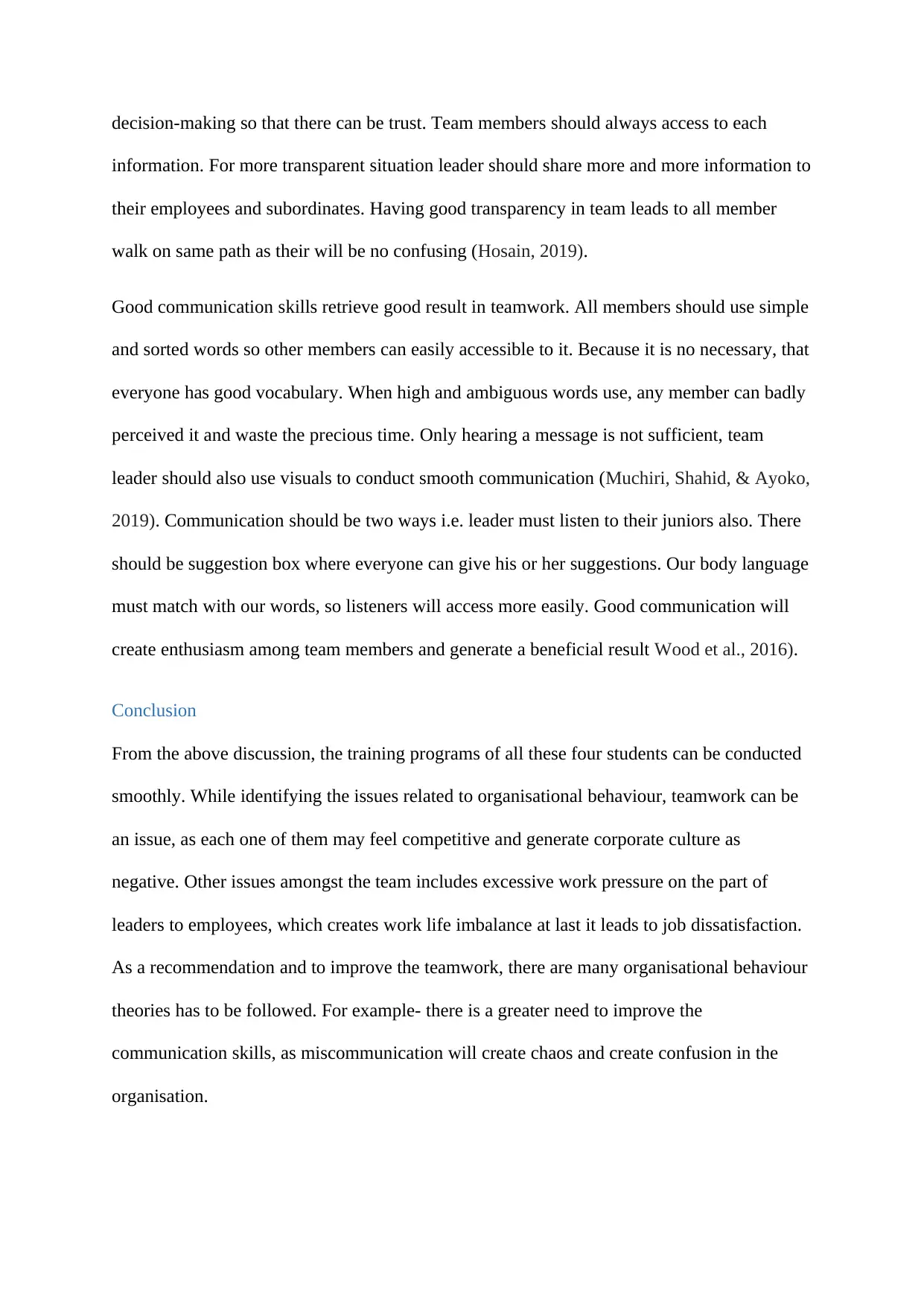
decision-making so that there can be trust. Team members should always access to each
information. For more transparent situation leader should share more and more information to
their employees and subordinates. Having good transparency in team leads to all member
walk on same path as their will be no confusing (Hosain, 2019).
Good communication skills retrieve good result in teamwork. All members should use simple
and sorted words so other members can easily accessible to it. Because it is no necessary, that
everyone has good vocabulary. When high and ambiguous words use, any member can badly
perceived it and waste the precious time. Only hearing a message is not sufficient, team
leader should also use visuals to conduct smooth communication (Muchiri, Shahid, & Ayoko,
2019). Communication should be two ways i.e. leader must listen to their juniors also. There
should be suggestion box where everyone can give his or her suggestions. Our body language
must match with our words, so listeners will access more easily. Good communication will
create enthusiasm among team members and generate a beneficial result Wood et al., 2016).
Conclusion
From the above discussion, the training programs of all these four students can be conducted
smoothly. While identifying the issues related to organisational behaviour, teamwork can be
an issue, as each one of them may feel competitive and generate corporate culture as
negative. Other issues amongst the team includes excessive work pressure on the part of
leaders to employees, which creates work life imbalance at last it leads to job dissatisfaction.
As a recommendation and to improve the teamwork, there are many organisational behaviour
theories has to be followed. For example- there is a greater need to improve the
communication skills, as miscommunication will create chaos and create confusion in the
organisation.
information. For more transparent situation leader should share more and more information to
their employees and subordinates. Having good transparency in team leads to all member
walk on same path as their will be no confusing (Hosain, 2019).
Good communication skills retrieve good result in teamwork. All members should use simple
and sorted words so other members can easily accessible to it. Because it is no necessary, that
everyone has good vocabulary. When high and ambiguous words use, any member can badly
perceived it and waste the precious time. Only hearing a message is not sufficient, team
leader should also use visuals to conduct smooth communication (Muchiri, Shahid, & Ayoko,
2019). Communication should be two ways i.e. leader must listen to their juniors also. There
should be suggestion box where everyone can give his or her suggestions. Our body language
must match with our words, so listeners will access more easily. Good communication will
create enthusiasm among team members and generate a beneficial result Wood et al., 2016).
Conclusion
From the above discussion, the training programs of all these four students can be conducted
smoothly. While identifying the issues related to organisational behaviour, teamwork can be
an issue, as each one of them may feel competitive and generate corporate culture as
negative. Other issues amongst the team includes excessive work pressure on the part of
leaders to employees, which creates work life imbalance at last it leads to job dissatisfaction.
As a recommendation and to improve the teamwork, there are many organisational behaviour
theories has to be followed. For example- there is a greater need to improve the
communication skills, as miscommunication will create chaos and create confusion in the
organisation.
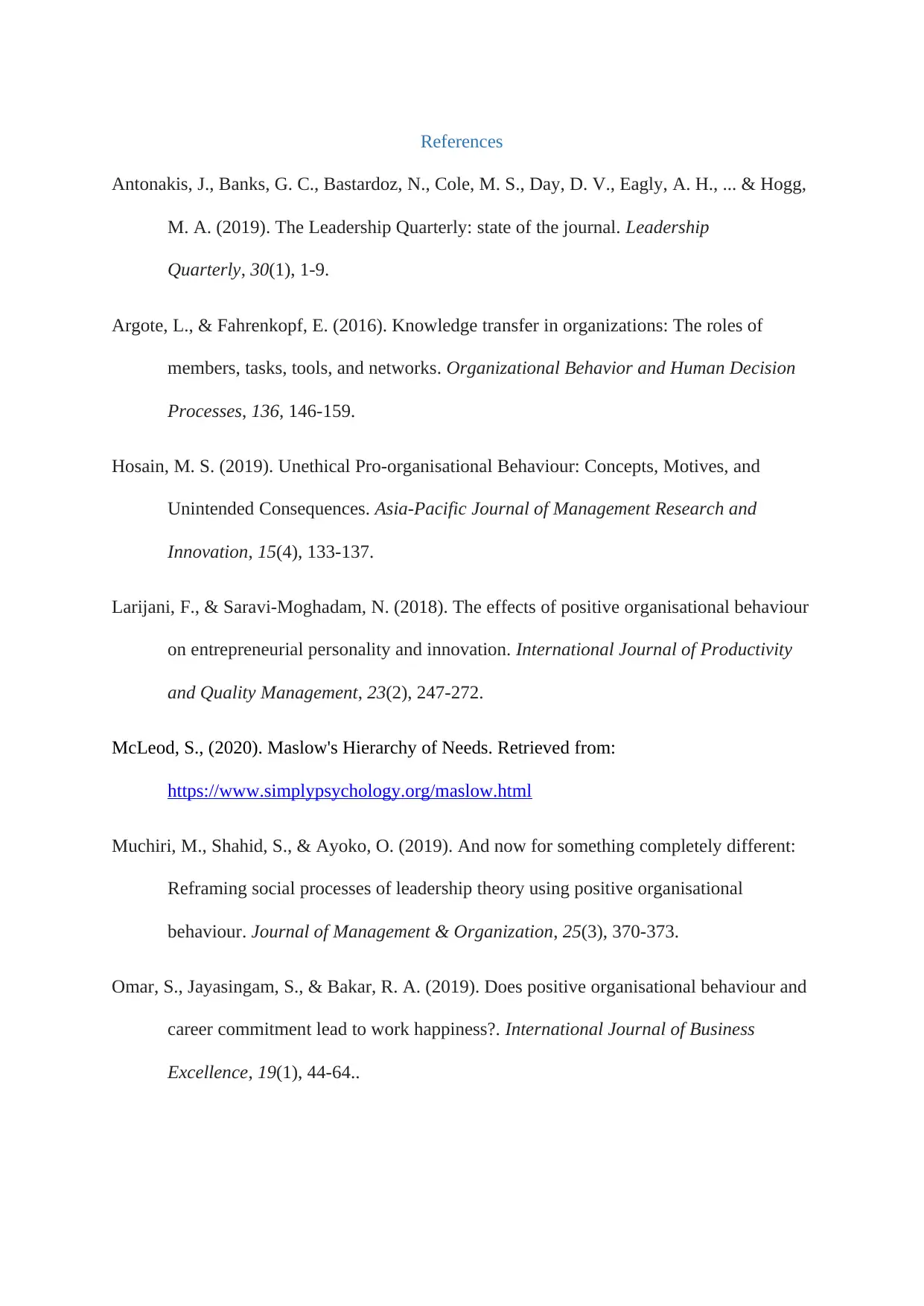
References
Antonakis, J., Banks, G. C., Bastardoz, N., Cole, M. S., Day, D. V., Eagly, A. H., ... & Hogg,
M. A. (2019). The Leadership Quarterly: state of the journal. Leadership
Quarterly, 30(1), 1-9.
Argote, L., & Fahrenkopf, E. (2016). Knowledge transfer in organizations: The roles of
members, tasks, tools, and networks. Organizational Behavior and Human Decision
Processes, 136, 146-159.
Hosain, M. S. (2019). Unethical Pro-organisational Behaviour: Concepts, Motives, and
Unintended Consequences. Asia-Pacific Journal of Management Research and
Innovation, 15(4), 133-137.
Larijani, F., & Saravi-Moghadam, N. (2018). The effects of positive organisational behaviour
on entrepreneurial personality and innovation. International Journal of Productivity
and Quality Management, 23(2), 247-272.
McLeod, S., (2020). Maslow's Hierarchy of Needs. Retrieved from:
https://www.simplypsychology.org/maslow.html
Muchiri, M., Shahid, S., & Ayoko, O. (2019). And now for something completely different:
Reframing social processes of leadership theory using positive organisational
behaviour. Journal of Management & Organization, 25(3), 370-373.
Omar, S., Jayasingam, S., & Bakar, R. A. (2019). Does positive organisational behaviour and
career commitment lead to work happiness?. International Journal of Business
Excellence, 19(1), 44-64..
Antonakis, J., Banks, G. C., Bastardoz, N., Cole, M. S., Day, D. V., Eagly, A. H., ... & Hogg,
M. A. (2019). The Leadership Quarterly: state of the journal. Leadership
Quarterly, 30(1), 1-9.
Argote, L., & Fahrenkopf, E. (2016). Knowledge transfer in organizations: The roles of
members, tasks, tools, and networks. Organizational Behavior and Human Decision
Processes, 136, 146-159.
Hosain, M. S. (2019). Unethical Pro-organisational Behaviour: Concepts, Motives, and
Unintended Consequences. Asia-Pacific Journal of Management Research and
Innovation, 15(4), 133-137.
Larijani, F., & Saravi-Moghadam, N. (2018). The effects of positive organisational behaviour
on entrepreneurial personality and innovation. International Journal of Productivity
and Quality Management, 23(2), 247-272.
McLeod, S., (2020). Maslow's Hierarchy of Needs. Retrieved from:
https://www.simplypsychology.org/maslow.html
Muchiri, M., Shahid, S., & Ayoko, O. (2019). And now for something completely different:
Reframing social processes of leadership theory using positive organisational
behaviour. Journal of Management & Organization, 25(3), 370-373.
Omar, S., Jayasingam, S., & Bakar, R. A. (2019). Does positive organisational behaviour and
career commitment lead to work happiness?. International Journal of Business
Excellence, 19(1), 44-64..
⊘ This is a preview!⊘
Do you want full access?
Subscribe today to unlock all pages.

Trusted by 1+ million students worldwide
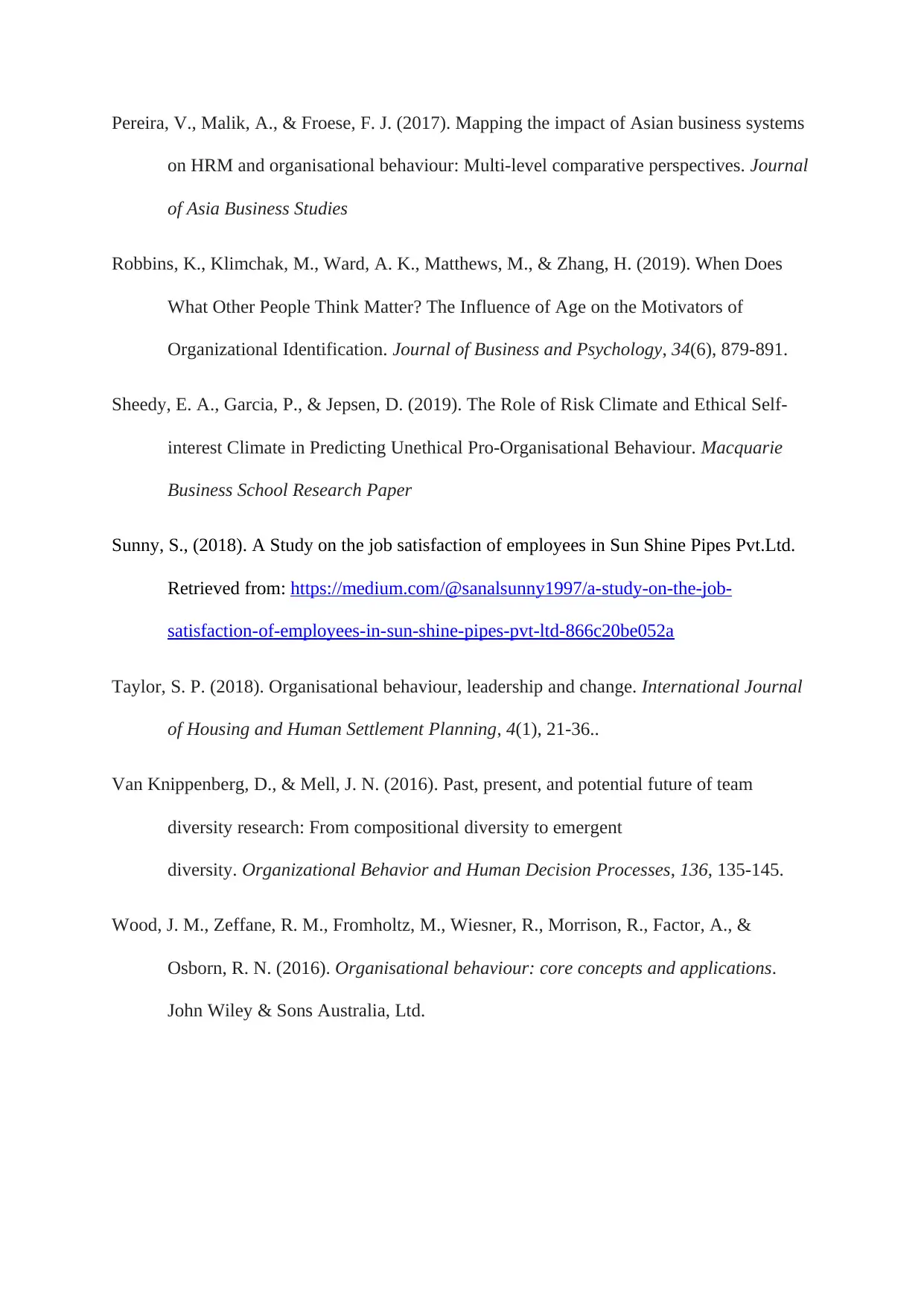
Pereira, V., Malik, A., & Froese, F. J. (2017). Mapping the impact of Asian business systems
on HRM and organisational behaviour: Multi-level comparative perspectives. Journal
of Asia Business Studies
Robbins, K., Klimchak, M., Ward, A. K., Matthews, M., & Zhang, H. (2019). When Does
What Other People Think Matter? The Influence of Age on the Motivators of
Organizational Identification. Journal of Business and Psychology, 34(6), 879-891.
Sheedy, E. A., Garcia, P., & Jepsen, D. (2019). The Role of Risk Climate and Ethical Self-
interest Climate in Predicting Unethical Pro-Organisational Behaviour. Macquarie
Business School Research Paper
Sunny, S., (2018). A Study on the job satisfaction of employees in Sun Shine Pipes Pvt.Ltd.
Retrieved from: https://medium.com/@sanalsunny1997/a-study-on-the-job-
satisfaction-of-employees-in-sun-shine-pipes-pvt-ltd-866c20be052a
Taylor, S. P. (2018). Organisational behaviour, leadership and change. International Journal
of Housing and Human Settlement Planning, 4(1), 21-36..
Van Knippenberg, D., & Mell, J. N. (2016). Past, present, and potential future of team
diversity research: From compositional diversity to emergent
diversity. Organizational Behavior and Human Decision Processes, 136, 135-145.
Wood, J. M., Zeffane, R. M., Fromholtz, M., Wiesner, R., Morrison, R., Factor, A., &
Osborn, R. N. (2016). Organisational behaviour: core concepts and applications.
John Wiley & Sons Australia, Ltd.
on HRM and organisational behaviour: Multi-level comparative perspectives. Journal
of Asia Business Studies
Robbins, K., Klimchak, M., Ward, A. K., Matthews, M., & Zhang, H. (2019). When Does
What Other People Think Matter? The Influence of Age on the Motivators of
Organizational Identification. Journal of Business and Psychology, 34(6), 879-891.
Sheedy, E. A., Garcia, P., & Jepsen, D. (2019). The Role of Risk Climate and Ethical Self-
interest Climate in Predicting Unethical Pro-Organisational Behaviour. Macquarie
Business School Research Paper
Sunny, S., (2018). A Study on the job satisfaction of employees in Sun Shine Pipes Pvt.Ltd.
Retrieved from: https://medium.com/@sanalsunny1997/a-study-on-the-job-
satisfaction-of-employees-in-sun-shine-pipes-pvt-ltd-866c20be052a
Taylor, S. P. (2018). Organisational behaviour, leadership and change. International Journal
of Housing and Human Settlement Planning, 4(1), 21-36..
Van Knippenberg, D., & Mell, J. N. (2016). Past, present, and potential future of team
diversity research: From compositional diversity to emergent
diversity. Organizational Behavior and Human Decision Processes, 136, 135-145.
Wood, J. M., Zeffane, R. M., Fromholtz, M., Wiesner, R., Morrison, R., Factor, A., &
Osborn, R. N. (2016). Organisational behaviour: core concepts and applications.
John Wiley & Sons Australia, Ltd.
1 out of 10
Related Documents
Your All-in-One AI-Powered Toolkit for Academic Success.
+13062052269
info@desklib.com
Available 24*7 on WhatsApp / Email
![[object Object]](/_next/static/media/star-bottom.7253800d.svg)
Unlock your academic potential
Copyright © 2020–2025 A2Z Services. All Rights Reserved. Developed and managed by ZUCOL.



